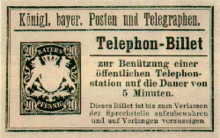Calling card

A phone card , prepaid phone card or a tax card is a card that can be used to make calls on suitable public telephones . These are usually located in telephone booths . For chip cards for mobile phones, see SIM card .
General
To make a call, the phone card usually has to be inserted into the phone's card slot so that the arrow markings on the card and the phone match.
For customers, the phone card has the advantage that you can not find a suitable change needed. Because a card phone does not require a coin container, it is cheaper for the operator, because on the one hand there is no longer a container to be emptied and on the other hand it cannot be stolen or broken into.
The disadvantage for the customer, however, is that a credit card has to be purchased for telephoning and that telephoning without an existing card is therefore not possible.
In the meantime, the number of public card phones is rapidly decreasing as cell phones become more widespread, essentially making phone booths superfluous, which are also maintenance-intensive and often damaged.
Systems
Different calling card systems have been used in some countries over time. Chip card systems have often proven to be particularly forgery-proof and have replaced other systems. Other frequently used systems are the Tamura and Anritsu magnetic stripe card system (the entire back of the card acts as a magnetic stripe ) and inductive cards (they contain induction coils ). At the same time, a calling card system has developed in many countries in which the credit is not stored on the card itself, but with the telecommunications service provider and is protected by an access code that can be scratched off on the card. There is no need to slide these cards into the phone. At the beginning of the 1990s, optical cards from Landis & Gyr and cards from GPT ( GEC Plessey Telecommunications ) with magnetic strips were common in some countries .
Country-specific history
Germany
Due to their supply mandate, market-dominant network operators are still obliged to provide public telephones. A field test was therefore carried out from April 2004 to the end of 2005, in which Telekom replaced the telephone booths with so-called base telephones at locations that were rarely used . The special thing about the base phones is that they do not have a slot for calling cards. Telephone calls can only be made with a calling card , credit card or 0800 freecall numbers.
Italy
Between 1927 and 2001 there were telephone coins called Gettone Telefonico . In the 1990s, cardboard-based phone cards were tested. The upper left corner had to be torn off before the first use to mark the card as used.
Austria
In Austria you could buy phone cards from the post office or from Telekom Austria . They were officially called telephone prepaid cards , but have not been sold since 2016.
In 1981 the first prepaid phone booth in Austria was put into operation. With the currency conversion from Schilling to Euro in 2001, the value indicated on the telephone cards also changed. Instead of “50 Schilling” you read the amount of “3.64 euros” on the last prepaid card, instead of “100 Schilling” “7.28 euros”. However, the displays were never converted to the new euro amounts on the prepaid cards. The prepaid phones continue to show “50” or “100” value units on their displays. Shortly after the euro changeover in 2002, prepaid phone cards were no longer sold in Austria. And yet there are still 470 telephone booths throughout Austria where you can make calls with a prepaid card, 50 of them in Lower Austria.
Switzerland
The Swiss name for a telephone card is Taxcard. The normal cards are sold by Swisscom . In 1996, the chip cards replaced Landis + Gyr's previous system. The tax cards of the standard series are available for 5, 10 and 20 Swiss francs . The motifs on these three cards each form a thematic unit.
Collector's item
Phonecards became collectors' items soon after their introduction. Similar to postage stamps , there are collectors' fairs, magazines and collective value catalogs (e.g. from Michel and Sherlock and the DeTe catalog).
Individual evidence
- ↑ All-Cards.net: Overview of the telephone card systems .
- ↑ Telephoning with Schilling prepaid cards orf.at, January 26, 2019, accessed January 26, 2019.
- ↑ Sherlock telephone card catalog, V2004.1, Wolfgang Zimmer Verlag, Frankfurt am Main 2004.
Web links
- "An almost obituary. The phone card turned 20" (www.teltarif.de)


